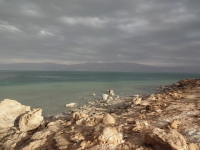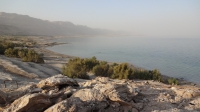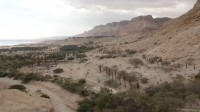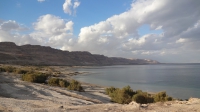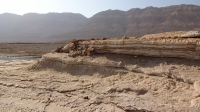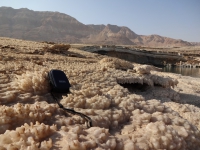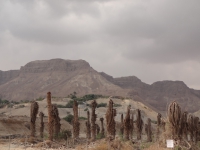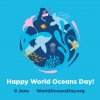Scientific diving mission in the Dead Sea: The salt lake is in danger
Science 10.12.2014The Dead Sea is not only very salty; it is also shrinking: Within the last 30 years, its water level has dropped by 28 meters – and this has consequences for humans and the environment. CMAS Scientific Divers from TU Bergakademie Freiberg, together with researchers from the German Helmholtz Center for Environmental Research (UFZ) and employees of the company EvoLogics, have been on site to find sublacustrine groundwater discharges on the lake’s bottom that will help to better understand the system.
The goal of the research mission in Israel was to better understand the ecosystem and the processes changing it. Prof. Dr. Broder J. Merkel, Dr. Thomas Pohl and M.Sc. Mandy Hoyer from the CMAS Scientific Diving Center (GERS00) of TU Bergakademie Freiberg had a hard time during their work at the Dead Sea. Desert climate, the tensed political situation as well as the extreme conditions in and around the water made the work on site be a real chal-lenge. According to Prof. Merkel the high density of the water, the buoyancy related to that as well as the aggressiveness of the brine were additionally challenging for the work under water. The water has salt contents of 28 percent on average – nearly ten-times higher than that of the world’s oceans. Without an additional weight of approximately 60 kilograms (mainly in the form of lead weights) per adult diver diving would not be possible there. The Scientific Diving Center of TUBAF trains scientists for scientific work under water. According to Prof. Merkel diving missions under such extreme conditions like in the Dead Sea, however, are rather exceptional.
On site the researchers from Freiberg, together with researchers from UFZ and the company EvoLogics, wanted to explore which consequences the drawdown of the water level of the Dead Sea has on the region and especially the groundwater of the region. This is also the goal of the Helmholtz joint project DESERVE. In this project hydro-geologists of the Helmholtz Center for Environmental Research together with micro-biologists from the German Leibniz Institute of Freshwater Ecology and Inland Fisheries (IGB) in Berlin have been studying the hydro-chemical and isotopic composition of the groundwaters for several years already. Since 2012 the colleagues from the UFZ cooperate with the divers from the SDC.
Different from what one would expect from its name, the Dead Sea is not a (marginal) sea but a terminal lake. Desert climate prevails in the region; and so water from the lake’s sur-face is permanently evaporating and the water level is dropping in case it is not balanced by water inflows. These natural inflows are altered by human activities: water from Jordan River, the main tributary of the Dead Sea, is diverted and used for irrigation in agriculture as well as for industry and private households. Water from the Dead Sea itself is being evaporated for producing bromine, iodine, magnesium, potassium and salts promoted to have healing effects from the residuals. In sum, all that leads to a dramatic drop of the lake’s water level. In comparison to the 1980 water level of 400 meters below sea level is today at 428 meters below sea level. Within the last two years it dropped by about three meters. Prognoses assume that the Dead Sea might nearly disappear within the next 50 years if the over-exploitation of the water resources continues with nowadays speed.
And this has far-reaching consequences for humans and the environment of the region. That is because the water of the Dead Sea is hydraulically connected with the surrounding groundwater. When the lake’s water level drops, the groundwater level automatically also drops. And so the already scarce resource water becomes even scarcer. Other consequences are massive sinkholes at the soil surface.
The scientific divers have not only been searching for sublacustrine groundwater discharges which enter the Dead Sea under the water surface close to the shore. Those can already be identified at the lake’s water surface due to differences in temperature and density. The scientists also wanted to characterize the inflowing waters quantitatively and qualitatively to understand how the dropping water level changes the system.
Now the water samples which were taken are being analyzed in Freiberg, Leipzig and Bre-men for the main and trace elements, inorganic and organic carbon content, hydrogen-, oxygen- and sulfur isotopes as well as the DNA of microorganisms. Even if the Dead Sea is not a habitat for fish, it is not dead at all; especially in the area of the sublacustrine groundwater discharges there are microorganisms. So, it keeps exciting which new findings the results will produce.
